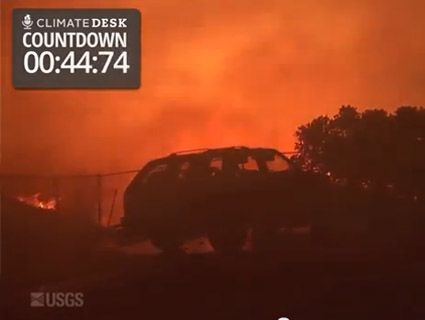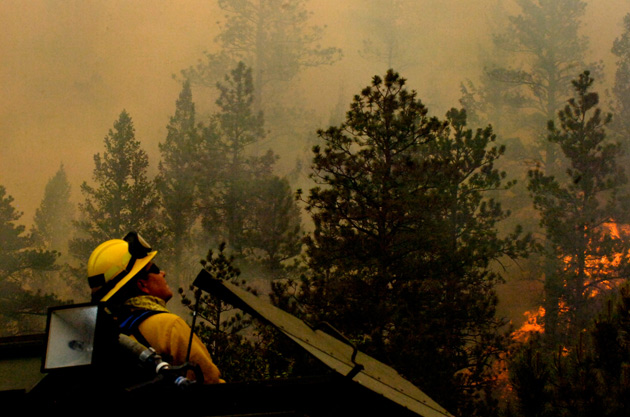Update Wed Aug 28 06:00 PM: As firefighters continued trying to contained the fire throughout the day on Wednesday, officials issued air quality warnings in Carson City and Reno, Nevada, due to the smoke coming in from over 100 miles away. On Tuesday night, the area of the burn zone in Yosemite doubled to 64 square miles, CBS News reports.
No one knows what started the Rim Fire, the 160,000 235,000 acre blaze that’s ripping through the western side of Yosemite National Park. But 3,700 4,300 firefighters have been dispatched to try to stop it using helicopters, bulldozers, and flame retardants. Although the situation is starting to look up—20 75 percent of the fire is now contained, up from 7 percent just two days ago—the authorities predict the fire will keep spreading, and fast, in days to come.
There are many reasons to be concerned about such a fire in Yosemite, even if you don’t live in California: For starters, it’s in our premier national park. Yosemite, which is about the size of Rhode Island, sees around 4 million visitors per year and is home to iconic groves of sequoia trees, endangered species like the California bighorn sheep, and some of the most famous peaks in the country, such as Half Dome and El Capitan. But the very things that make Yosemite so beautiful—its pristine condition, steep ravines, and tall trees—are also fueling this fire and making it difficult to contain.
Here are a few factors that make this fire especially terrifying:
1. It’s huge.
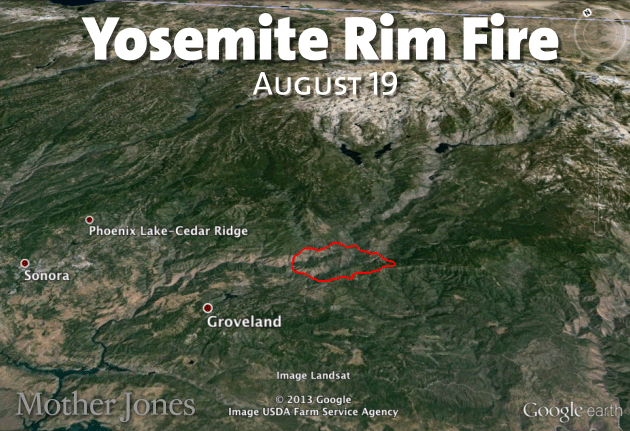
GIF: Brett Brownell / Fire perimeter data: National Wildlife Coordinating Group
The fire is now one of the 20 7 largest fires in California history. It started on August 17 in a remote area of the forest and initially doubled in size every day. Currently, it’s bigger than Chicago and threatens 4,500 human structures, though relatively few—23 111, including a summer camp—have been destroyed.
Here is an image of the fire taken by NASA’s Aqua satellite on August 22:
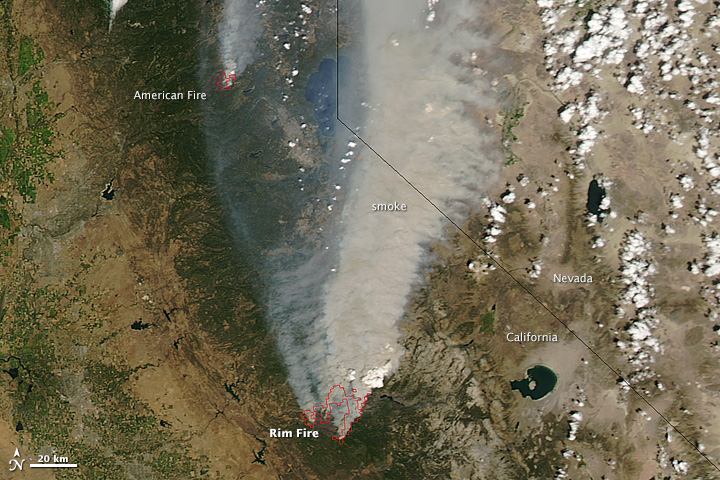
…and here’s a larger version of that same photo, where the fire is clearly visible in an aerial view of the entire state of California:
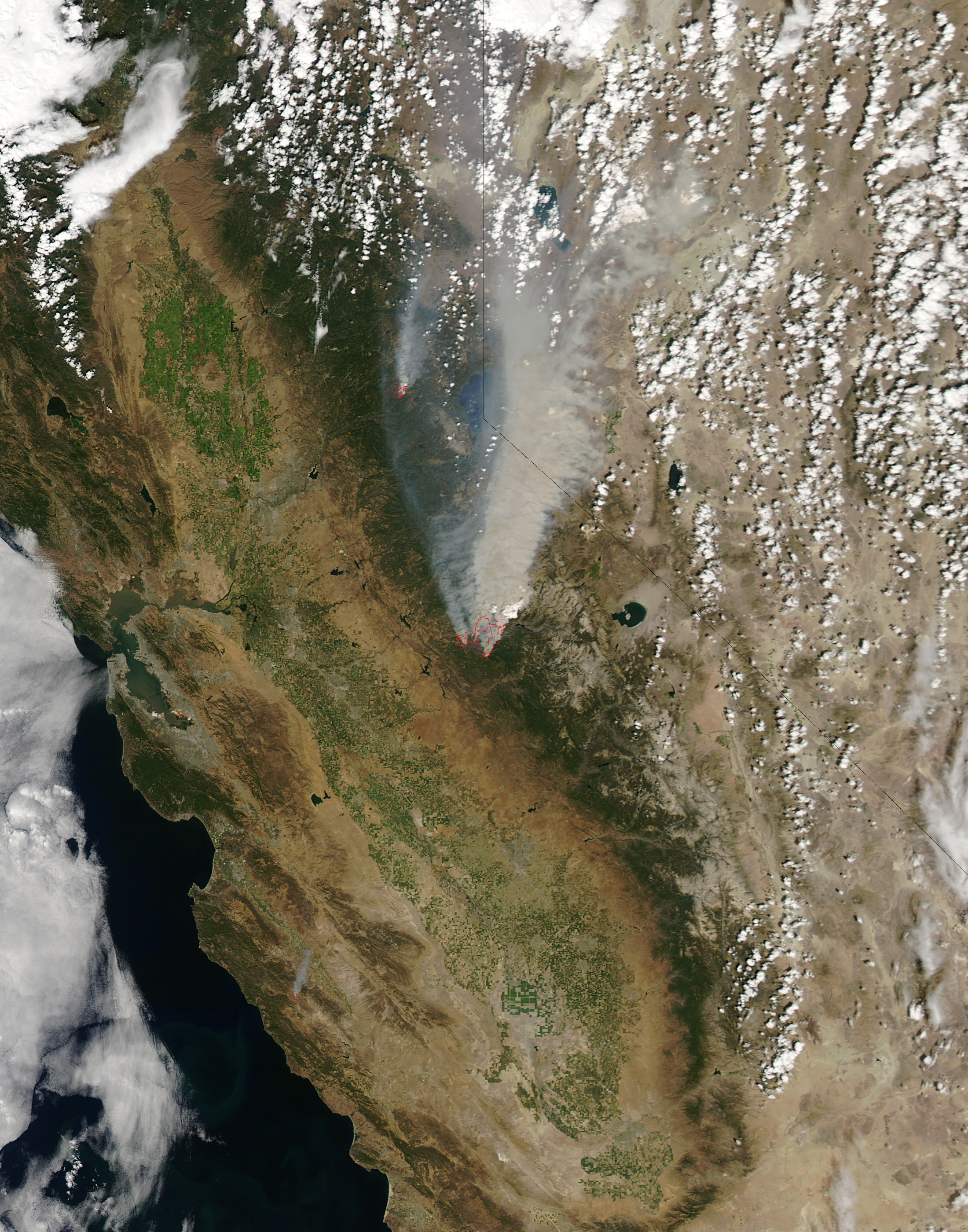
In the video below, shot by the California National Guard, you can see the fire extending for miles. “That is unreal,” one of the pilots comments as the rim of the fire comes into sight:
2. It’s growing quickly.
The fire has two layers: It’s spreading through both the dry brush on the ground and up above in the canopy of the treetops. “Our firefighters are on the ground having to spray up,” Daniel Berlant of the California Department of Forestry and Fire Protection told CBS News on Sunday.
As of Tuesday, it was spreading towards Tuolumne City, a logging town west of Yosemite. InciWeb, the information service from the US Forest Service and several other federal government agencies, says the Rim Fire is “expected to continue to exhibit very large fire growth” in the coming days.
Right now, Yosemite Valley—home of the iconic El Capitan and Half Dome granite rock formations, as well as waterfalls and hiking trails—is safe, about 20 miles away from the edge of the fire.
Residents of the Yosemite area report that the conditions this summer have been particularly hot and dry, and that watching the fire spread through the dry, abundant brush with ease is unsettling.
“I watched a patch of ground—bone dry and full of brush—burst into flame from a little unseen spark and then blossom, before my eyes, into a wall of flame,” says Geoff Quinn, a physician and amateur photographer who lives near Yosemite and has been frequently photographing the Rim fire. “Once the excess brush, the excess dryness, are in place, its too late to stop it.”
“It’s just been a long, hot, feiry summer,” says Beth Pratt, the California director for the National Wildlife Federation, who spent 10 years working in the Yosemite and has lived on the southwest border of the park for 15 years. “I have never seen so much fire.”
3. It’s really, really hard to fight.
The steep, remote topography of western Yosemite makes it difficult for firefighters to get the blaze. Narrow rivers flowing down the peaks cool the air, which makes the wind blow in all kinds of directions, says Julie Hutchinson, battalion chief and information officer for the California Department of Forestry and Fire Protection. The result is that the flames spread in various directions, making it hard to predict where it will go next.
“It was very difficult to get crews into it to for the initial attack on the fire,” explains Bobby Reiss, a public information officer with the Forest Service. It’s also difficult to use firefighting equipment in those areas.
4. It could cut off San Francisco’s water supply.
Over the weekend, California Gov. Jerry Brown declared a state of emergency for San Francisco because the city gets over 80 percent of its water—more than 237 million gallons per day—from the Hetch Hetchy reservoir, which is currently only four miles away from the edge of the Rim Fire, according to the Associated Press. The San Francisco Public Utilities Commission (SFPUC) said Monday that the city’s drinking water remains safe, despite the thick smoke and ash that’s reportedly clouding the area.
5. It caused the city of San Francisco to shut down its power sources and buy energy on the market instead.
Because of the fire, the state shut down two of the three hydroelectric power stations in Hetch Hetchy. Normally, the three stations supply virtually all power for city services, including the San Francisco airport, fire and police departments, and hospitals. SFPUC estimates that both the city’s electricity and water supplies are safe for now and it’s repairing the plants, and the city has spent $600,000 buying energy elsewhere to stay powered in the meantime.
6. Two groves of treasured sequoia trees are currently within miles of the fire.
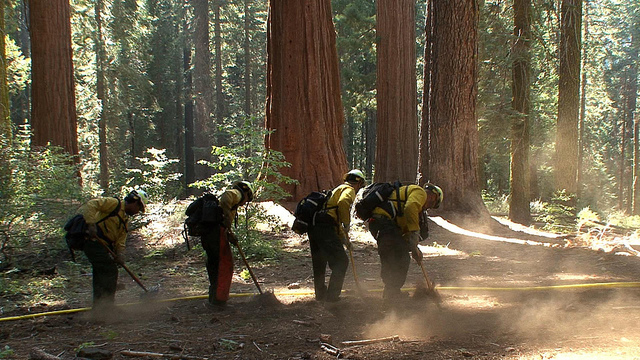
The fire is close to two of Yosemite’s three groves of sequoia trees, the Tuolumne Grove and the Merced Grove. Firefighters have surrounded the sequoias, many of which stand hundreds of feet high and are well over a thousand years old, with sprinklers and cleared the area of brush to try to keep the fire at bay.
7. Summer tourism in the area has tanked.
For businesses near Yosemite, this would have been peak tourism season had the fire not led thousands of visitors to evacuate from the park. Bad air quality, road closures, and concern about the fire have driven traffic down in all of Tuolumne County. The general manager of a casino in Tuolumne told the Sacramento Bee he expected to see only a few dozen customers come in last Saturday, as opposed to the 2,000 to 3,000 a summer weekend would usually draw.
8. The fire is so big it has its own weather system.

The Rim Fire has gotten big enough that it’s creating its own weather patterns, state officials say. According to Hutchinson, this phenomenon isn’t uncommon with large forest fires. “As a fire gets big and starts consuming more and more vegetation, all that heat that’s been generated and all that electricity that’s been generated goes up into a smoke column and it will almost create its own thunder head,” says Hutchinson. “It has the same ability as a thunder cell does to break loose and change the weather patterns in and around it.” In other words, large clouds form above the fire (like the clouds that form above a volcano) that don’t produce precipitation, but create strong and unpredictable winds that can change how the fire spreads.
9. This fire could be a sign of things to come.
Though this season hasn’t been a particularly bad season for wildfires so far, there’s reason to be concerned that fires will only grow larger and more frequent as hot, dry weather becomes increasingly common in the West. Fire season now lasts two months longer and destroys twice as much land as it did 40 years ago, according to Thomas Tidwell, the head of the United States Forest Service, who testified to the Senate committee on energy and natural resources earlier this summer.
We can expect “as much as a fourfold increase in parts of the Sierra Nevada and California” in fire activity across the rest of this century, Matthew Hurteau, assistant professor of ecosystem science and management at Penn State University, recently told Mother Jones. (Read Mother Jones‘ explainer on how climate change is making wildfires worse here.)
In Yosemite, Hutchinson says the dry conditions this summer makes the park’s vegetation “very receptive” both to the wildfire, and to its spread across the park. “We were seeing summer temperatures in April and May,” she added. “The grass, the brush, and the timber—they are very dry and they’re stressed.”
